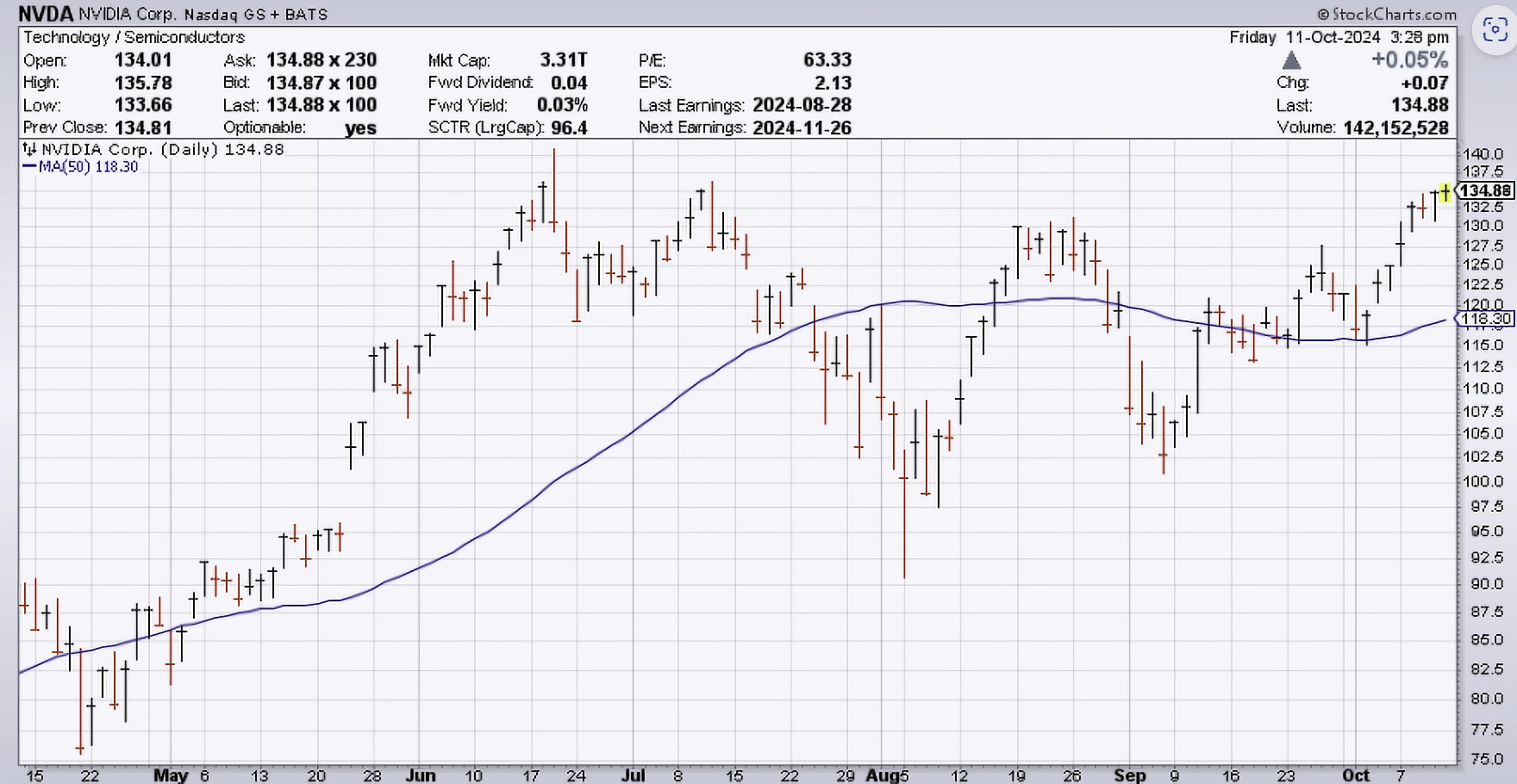Will Nvidia Earnings Be the Breakout Catalyst for the Chip Stock?

Editor’s note: Any and all references to time frames longer than one trading day are for purposes of market context only, and not recommendations of any holding time frame. Daily rebalancing ETFs are not meant to be held unmonitored for long periods. If you don’t have the resources, time or inclination to constantly monitor and manage your positions, leveraged and inverse ETFs are not for you.
Investing in the funds involves a high degree of risk. Unlike traditional ETFs, or even other leveraged and/or inverse ETFs, these leveraged and/or inverse single-stock ETFs track the price of a single stock rather than an index, eliminating the benefits of diversification. Leveraged and inverse ETFs pursue daily leveraged investment objectives, which means they are riskier than alternatives which do not use leverage. They seek daily goals and should not be expected to track the underlying stock’s performance over periods longer than one day. They are not suitable for all investors and should be utilized only by investors who understand leverage risk and who actively manage their investments. The Funds will lose money if the underlying stock’s performance is flat, and it is possible that the Bull Fund will lose money even if the underlying stock’s performance increases, and the Bear Fund will lose money even if the underlying stock’s performance decreases, over a period longer than a single day. An investor could lose the full principal value of his or her investment in a single day. Investing in the Funds is not equivalent to investing directly in NVDA.
Doubt NVIDIA Corporation (Ticker: NVDA) at your peril. Shares found a low in early August and have been grinding higher despite persistent calls of an artificial intelligence (AI) bubble and talk of the stock being too richly valued. Now, the stock finds itself at the top end of its recent range, threatening to break out to new split-adjusted highs ahead of NVIDIA’s upcoming third-quarter earnings report expected to cross on November 20.
Below is a daily chart of NVDA, as of October 11, 2024.

Source: StockCharts.com, October 11, 2024.
Candlestick charts display the high and low (the stick) and the open and close price (the body) of a security for a specific period. If the body is filled, it means the close was lower than the open. If the body is empty, it means the close was higher than the open.
The performance data quoted represents past performance. Past performance does not guarantee future results.
For traders looking to play either the bullish or bearish side, there are several key catalysts in the next couple months that could provide opportunities.
AI Summit Developments
NVIDIA held its AI Summit in October 2024. As Finbold reports, the chip giant and tech bellwether showcased its efforts in boosting AI model performance with the GB200 NVL72 system components and NVIDIA Inference Microservices (NIMs).
The summit also emphasized how NVIDIA is addressing the growing need for more efficient data processing and networking in AI applications. With AI model training and inference becoming increasingly demanding on hardware infrastructure, NVIDIA is looking to meet these challenges, and profit. A notable takeaway from the summit was the company’s focus on the energy efficiency of its AI systems, a crucial factor given the massive power requirements of modern data centers. NVIDIA’s continued advancements in AI-driven technologies, such as autonomous systems and digital twins, further underscore its leadership position in this rapidly evolving sector.
These announcements serve as a double-edged sword for traders, though. On one hand, the breakthroughs could fuel further bullish momentum if the market responds favorably to NVIDIA’s innovation and leadership. On the other hand, if the excitement fades or competitors respond with their own advances, traders looking to short the stock could find opportunities.
Upcoming Earnings
NVIDIA is slated to release its Q3 fiscal 2025 earnings in November, a highly anticipated event that may inject significant volatility into the stock. After several quarters of robust performance driven by AI chip demand, investors and traders alike will be looking for any signs of growth or slowdown in this critical sector. AI infrastructure spending is expected to remain strong, but if the company’s guidance or results miss lofty expectations, the stock could see sharp declines.
On the flip side, a strong earnings beat, particularly if coupled with bullish guidance for the holiday quarter, could push NVDA to new highs on a split-adjusted basis. Given the stakes, both long and short traders should prepare for major moves around this event.
Blackwell and Product Pipeline
NVIDIA’s Blackwell architecture and its next-generation AI chips are set to remain a core driver of the stock. CEO Jensen Huang recently commented on the “insane” demand for these chips, according to CNBC. Huang emphasized that NVIDIA is ramping up production to meet the skyrocketing demand across sectors like data centers and AI-driven enterprises.
Traders should watch for updates on the progress of Blackwell demand. If demand continues to outpace expectations, bullish traders might find momentum to the upside. Conversely, any production delays or competitive threats could provide bearish traders with downside opportunities.
Be Ready for Both Sides
NVDA remains a stock that thrives on proving its doubters wrong. With its leadership in AI computing, multiple catalysts in the near term—including potential follow-ups from the AI Summit, an earnings report, and Blackwell updates—traders should expect plenty of volatility*.
For traders bullish on NVDA, the Direxion Daily NVDA Bull 2X Shares (Ticker: NVDU) offers a way to amplify exposure. This leveraged ETF seeks daily investment results, before fees and expenses, of 200% of the performance of NVIDIA Corporation’s common stock. On the other hand, NVDA bears can attempt to take advantage of weakness in the name with the Direxion Daily NVDA Bear 1X Shares (Ticker: NVDD). This inverse ETF seeks daily investment results, before fees and expenses, of 100% of the inverse (or opposite) of the performance of NVIDIA Corporation’s common stock.
*Definitions and Index Descriptions
An investor should carefully consider a Fund’s investment objective, risks, charges, and expenses before investing. A Fund’s prospectus and summary prospectus contain this and other information about the Direxion Shares. To obtain a Fund’s prospectus and summary prospectus call 866-476-7523 or visit our website at direxion.com. A Fund’s prospectus and summary prospectus should be read carefully before investing.
The Funds have derived all disclosures contained in this document regarding NVIDIA Corporation from publicly available documents. In connection with the offering of each Fund’s securities, neither the Funds, the Trust, nor the Adviser or any of its respective affiliates has participated in the preparation of such documents. Neither the Funds, the Trust nor the Adviser or any of its respective affiliates makes any representation that such publicly available documents or any other publicly available information regarding NVIDIA Corporation is accurate or complete. Furthermore, the Funds cannot give any assurance that all events occurring prior to the date hereof (including events that would affect the accuracy or completeness of the publicly available documents described above) that would affect the trading price of NVIDIA Corporation have been publicly disclosed. Subsequent disclosure of any such events or the disclosure of or failure to disclose material future events concerning NVIDIA Corporation could affect the value of a Fund’s investments with respect to NVIDIA Corporation and therefore the value of the Funds.
Direxion Shares Risks – An investment in a Fund involves risk, including the possible loss of principal. Each Fund is non-diversified and includes risks associated with a Fund concentrating its investments in a particular security, industry, sector, or geographic region which can result in increased volatility. A Fund’s investments in derivatives such as futures contracts and swaps may pose risks in addition to, and greater than, those associated with directly investing in securities or other investments, including imperfect correlations with underlying investments or the Fund’s other portfolio holdings, higher price volatility and lack of availability. As a result, the value of an investment in a Fund may change quickly and without warning.
Leverage Risk – The Bull Fund obtains investment exposure in excess of its net assets by utilizing leverage and may lose more money in market conditions that are adverse to its investment objective than a fund that does not utilize leverage. A total loss may occur in a single day. Leverage will also have the effect of magnifying any differences in the Fund’s correlation with NVDA and may increase the volatility of the Bull Fund.
Daily Correlation Risk – A number of factors may affect the Bull Fund’s ability to achieve a high degree of correlation with NVDA and therefore achieve its daily leveraged investment objective. The Bull Fund’s exposure to NVDA is impacted by NVDA’s movement. Because of this, it is unlikely that the Bull Fund will be perfectly exposed to NVDA at the end of each day. The possibility of the Bull Fund being materially over- or under-exposed to NVDA increases on days when NVDA is volatile near the close of the trading day.
Daily Inverse Correlation Risk – A number of factors may affect the Bear Fund’s ability to achieve a high degree of inverse correlation with NVDA and therefore achieve its daily inverse investment objective. The Bear Fund’s exposure to NVDA is impacted by NVDA’s movement. Because of this, it is unlikely that the Bear Fund will be perfectly exposed to NVDA at the end of each day. The possibility of the Bear Fund being materially over- or under-exposed to NVDA increases on days when NVDA is volatile near the close of the trading day.
NVIDIA Corporation Investing Risk — NVIDIA Corporation faces risks associated with meeting the evolving needs of its large markets – gaming, data center, professional visualization and automotive – and identifying new products, services and technologies; competition in its current and target markets; changes in customer demand; supply chain issues; manufacturing delays; potential significant mismatches between supply and demand giving rise to product shortages or excessive inventory; the dependence on third-parties and their technology to manufacture, assemble, test, package or design its products which reduces control over product quantity and quality, manufacturing yields, development, enhancement and product delivery schedules; significant product defects; international operations, including adverse economic conditions; impacts from climate change, including water and energy availability; business investment and acquisitions; system security and data protection breaches, including cyberattacks; business disruptions; a limited number of customers; the ability to attract, retain and motivate executives and key employees; the proper function of its business processes and information systems; its intellectual property; and other regulatory and legal issues.
Semiconductor Industry Risk – Semiconductor companies may face intense competition, both domestically and internationally, may have limited product lines, markets, financial resources or personnel and may face risks related to the availability of materials.
Technology Sector Risk — The market prices of technology-related securities tend to exhibit a greater degree of market risk and sharp price fluctuations than other types of securities. These securities may fall in and out of favor with investors rapidly, which may cause sudden selling and dramatically lower market prices.
Additional risks of each Fund include Effects of Compounding and Market Volatility Risk, Derivatives Risk, Counterparty Risk, Rebalancing Risk, Intra-Day Investment Risk, Industry Concentration Risk, Market Risk, Indirect Investment Risk, and Cash Transaction Risk. Additionally, for the Direxion Daily NVDA Bear 1X Shares, Shorting or Inverse Risk. Please see the summary and full prospectuses for a more complete description of these and other risks of a Fund.